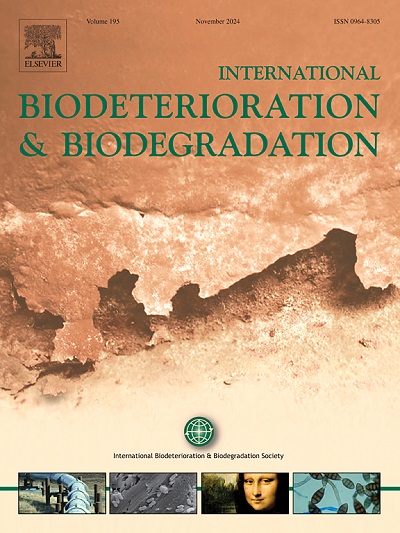Identification of the key factors influencing biodeterioration of open-air cultural heritage in the temperate climate zone of China
IF 4.1
2区 环境科学与生态学
Q2 BIOTECHNOLOGY & APPLIED MICROBIOLOGY
International Biodeterioration & Biodegradation
Pub Date : 2024-11-16
DOI:10.1016/j.ibiod.2024.105954
引用次数: 0
Abstract
Biodeterioration is known to cause irreversible damage to open-air cultural heritages. China has numerous open-air cultural heritages constructed of stone and brick, but very little information is available about the factors involved in their biodeterioration. In this study, different kinds of open-air cultural heritages (steles, towers, temples, Tang-ling carvings, and stone bridges) from 14 different locations in temperate climate zone of China were collected and investigated. Microbiological characteristics of these cultural heritages revealed that both cyanobacteria and lichens were the mainly dominant groups on these open-air stone and brick cultural heritages with visible deterioration. Cyanobacteria were closely associated with the severely deteriorated Tang-ling carvings wile lichens were most commonly found on temples and bridges. The main cyanobacteria were Oscillatoria, Pleurocapsa, and Lyngbya, and the dominant lichens were Xanthoria Th. Fr., Lepraria. Ach. and Camellia on the surface of cultural heritage. In addition, the extent of deterioration associated with cyanobacteria exhibited an increasing trend with higher annual mean sunshine intensity, calcite content, and cultural heritage age though not statistically significant. Redundancy analysis indicated that sunshine intensity and the age of the archeological structures were the key factors that significantly affected the biodeterioration of cultural heritages. This study provides more understanding of the microbial community associated with deterioration of open-air cultural heritages situated at the temperate climate zone of China.
确定影响中国温带气候区露天文物生物退化的关键因素
众所周知,生物退化会对露天文物造成不可逆转的破坏。中国有大量的石质和砖质露天文物,但有关其生物劣化因素的信息却很少。本研究收集并调查了中国温带气候区 14 个不同地点的各种露天文物(石碑、塔、寺庙、唐陵雕刻和石桥)。这些文物的微生物学特征表明,蓝藻和地衣是这些有明显退化的露天石砖文物上的主要优势菌群。蓝藻与严重破损的唐陵石刻密切相关,而地衣则多见于寺庙和桥梁。主要的蓝藻有 Oscillatoria、Pleurocapsa 和 Lyngbya,主要的地衣有 Xanthoria Th. Fr.Fr.、Lepraria.Ach. 和山茶花。此外,随着年平均日照强度、方解石含量和文物年代的增加,与蓝藻相关的劣化程度呈上升趋势,但无统计学意义。冗余分析表明,日照强度和考古结构的年代是显著影响文物生物劣化的关键因素。本研究有助于进一步了解中国温带气候区露天文物退化的相关微生物群落。
本文章由计算机程序翻译,如有差异,请以英文原文为准。
求助全文
约1分钟内获得全文
求助全文
来源期刊
CiteScore
9.60
自引率
10.40%
发文量
107
审稿时长
21 days
期刊介绍:
International Biodeterioration and Biodegradation publishes original research papers and reviews on the biological causes of deterioration or degradation.

 求助内容:
求助内容: 应助结果提醒方式:
应助结果提醒方式:


